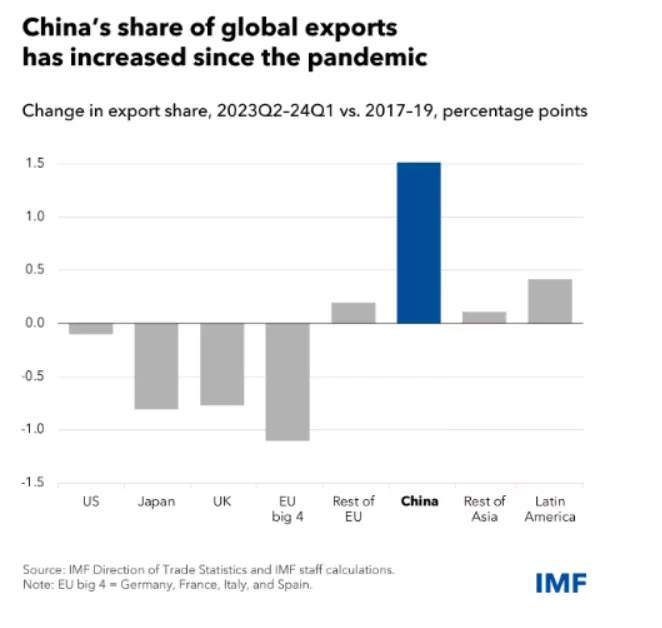 Image Source:
Image Source:
Yet again, the US administration sends a high-level trade delegation to Beijing to discuss curtailing its exports, not only to the US but to the rest of the world. Over the past year, the US Secretary of Treasury and Secretary of Commerce undertook the long flight to Beijing to cajole Chinese officials to reduce their manufacturing overcapacity. The latest effort is lead by the US Treasury undersecretary for International Affairs. Just why is the US so eager to curb Chinese manufacturing? This time around the US is speaking not only for itself but on more global scale. Simply, China’s enormous manufacturing sector is taking away market share from many of the largest trading blocs. China has increased is share of global exports while the US, EU, and Japan have lost ground since the pandemic starting in 2019. The indicate that 128 countries now trade more with China than with the US. To further its trade ambitions, China has spent more than a trillion dollars throughout Asia and the Middle East on infrastructure projects as part of its Belt and Road Initiatives, including high-speed rail, bridges, seaports, and roads. The trade imbalances have resulted in China becoming the largest foreign US creditor and the world’s largest trading power. Like King Canute, the US is desperate to hold back the tidal wave. The great China-US trade rivalry has now expanded to China vs the world. Nevertheless, the US administration is adamant that it is necessary to decrease significantly its huge trade deficit with China, despite warnings from trade specialists that efforts to decouple would only result in an overall decline in global growth.The US has introduced, under the Trump Administration, tariffs aimed directly at Chinese imports. The Biden Administration has, not only maintained those tariffs but introduced a raft of export controls on specific technologies and a series of subsidies to promote manufacturing in clean energy, electronic vehicles, and semiconductors. Despite US protectionism, China’s worldwide exports grew by 8.6% y/y last quarter. This export performance comes at a critical time for China as struggles with weaken domestic demand and a credit crunch in the property market.
The indicate that 128 countries now trade more with China than with the US. To further its trade ambitions, China has spent more than a trillion dollars throughout Asia and the Middle East on infrastructure projects as part of its Belt and Road Initiatives, including high-speed rail, bridges, seaports, and roads. The trade imbalances have resulted in China becoming the largest foreign US creditor and the world’s largest trading power. Like King Canute, the US is desperate to hold back the tidal wave. The great China-US trade rivalry has now expanded to China vs the world. Nevertheless, the US administration is adamant that it is necessary to decrease significantly its huge trade deficit with China, despite warnings from trade specialists that efforts to decouple would only result in an overall decline in global growth.The US has introduced, under the Trump Administration, tariffs aimed directly at Chinese imports. The Biden Administration has, not only maintained those tariffs but introduced a raft of export controls on specific technologies and a series of subsidies to promote manufacturing in clean energy, electronic vehicles, and semiconductors. Despite US protectionism, China’s worldwide exports grew by 8.6% y/y last quarter. This export performance comes at a critical time for China as struggles with weaken domestic demand and a credit crunch in the property market.
US policy to curtail Chinese imports has failed for several reasons:
at Capital Economics, “Overall, we expect exports to remain a near-term tailwind to economic growth,” for China.Long term, it is far from certain that China’s dominance in global trade will wane. Those hoping that the multinational manufacturing entities will “reshore” to the US in response to US subsidies and other forms of protectionism have yet to make that case in concrete terms. Apple, for example, is moving its Chinese operations to other Asian countries, such as Vietnam and Laos, to take advantage of yet wages and possibly anticipating further US protectionist measures. Meanwhile, it looks as if the US in on a fool’s errand as tries to talk China into cutting back its manufacturing capacity, especially as world trade growth softens.More By This Author:Canada Will Be Caught In The Rise In US Trade Protection Measures The Canadian Banks Find Reasons Not To Give Out Loans Faced With Declining Employment Levels The Bank Of Canada Needs To Act Quickly

